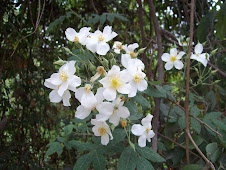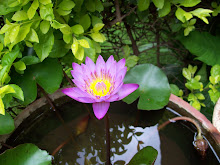Humans have been extracting oil from plants since pre-historic times. More and more uses have been found for the vegetable oils.

Jatropha, the plant with the red flowers, yields an oil which is used as a substitute for deisel in some parts of the world. I visited an organic farm called Navadarshanam near Bangalore, where they use the Jatropha oil to run their flour mill. The waste is composted.
There are innumerable uses for the coconut oil, which has been known to humans for millenia. Coconut oil is used as a cooking medium, for the preparation of beauty aids, as an addition to food, for making soap, in industry...
The tree you see on the right hand corner is the sandalwood tree. It gives a very precious oil which is used in the perfume industry, and also for religious purposes by the Hindus and the Buddhists.
 This is the famale flower of the Chikki green, which looks like it is made of paper. The Chikki leaves are a popular salad green. It has a slightly sour taste, which adds a tang to the salad.
This is the famale flower of the Chikki green, which looks like it is made of paper. The Chikki leaves are a popular salad green. It has a slightly sour taste, which adds a tang to the salad. The leaves can also be cooked and eaten with dal or ground into a tasty chutney. The leaves are very nutritious like the spinach.Unlike the spinach, chikki leaves are very delicate and cook within seconds. It retains its slight sour taste even after cooking, so that you don't have to add lemon juice .
The leaves can also be cooked and eaten with dal or ground into a tasty chutney. The leaves are very nutritious like the spinach.Unlike the spinach, chikki leaves are very delicate and cook within seconds. It retains its slight sour taste even after cooking, so that you don't have to add lemon juice .
















































